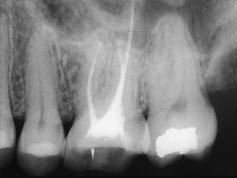anatomy cases
Objectives
At the conclusion of this case, the reader should be familiar with the possible signs/symptoms of an untreated root canal following conventional root canal treatment. The reader should also know the likely variations in tooth morphology and the techniques used to discover additional root canal anatomy.
Introduction
A 32-year-old female presented with persistent thermal sensitivity following root canal treatment on her upper left first molar tooth.
Chief complaint
The patient complained of pain to hot and cold liquids, especially while eating or drinking, on the upper left side. The sensitivity appeared to be localized to the 26.
Medical history
Non-contributory.
Dental history
Root canal treatment of the 26 had been completed by her general dental practitioner in one visit, approximately 4 weeks previously. There had been no other recent restorations placed in the quadrant.
Clinical examination
There was a composite restoration in the access cavity of the 26. The 27 had an occlusal amalgam restoration, and the 14 and 15 had occlusal composite restorations. All appeared in good repair without voids. There was no caries (new or recurrent) visible on radiographs of the quadrant, and examination with the dental operating microscope (DOM) revealed no fractures present in the crowns of any of the teeth.
The 26 reacted positively to both hot and cold tests, however, the sensation lingered after removal of the stimulus. The 27 reacted positively without lingering discomfort. Percussion/palpation/biting tests were within normal limits for all teeth in the quadrant. There were no periodontal probing depths in excess of 4 mm.
A periapical radiograph taken of the 25–27 revealed a root filling in the 26 (Figure 5.8.1). It appeared that three root canals had been treated. No obvious apical radiolucencies could be seen around any of the teeth. The canals which had been previously treated appeared to be within 0–2 mm of the radiographic apex.
Figure 5.8.1 A pre-operative radiograph of the 25–27. In the 26, a root canal obturation can be seen in three canals.

Diagnosis and treatment planning
Can thermal sensitivity be detected in a necrotic or endodontically treated tooth?
Thermal sensitivity is normally associated with a vital pulp and is an unusual finding in a tooth that has previously been root treated. However, occasionally, vital tissue can remain either within poorly debrided canals or in another canal which has not been treated. Therefore, it is incumbent that the treating dentist does not automatically discount the root treated tooth in the differential diagnosis of thermal sensitivity (Table 5.8.1).
Table 5.8.1 Possible signs/symptoms of unexplored root canal anatomy
|
Stay updated, free dental videos. Join our Telegram channel

VIDEdental - Online dental courses


